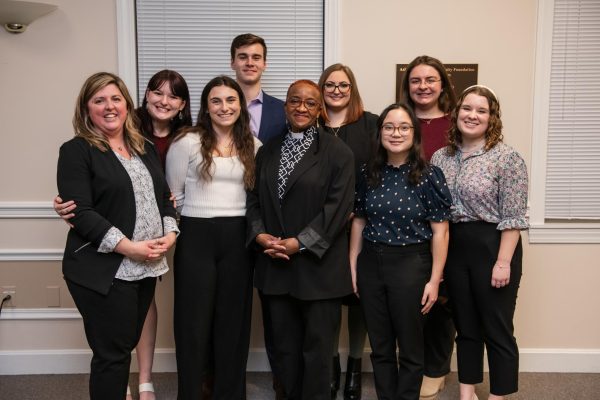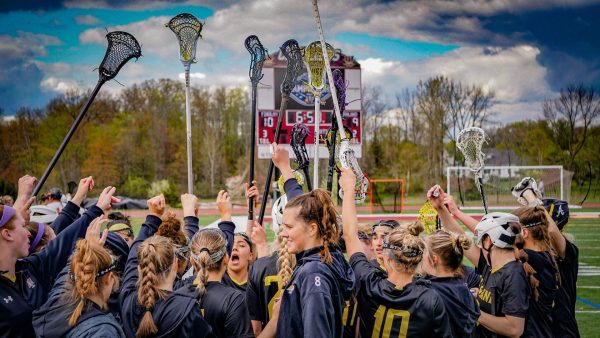Which coronavirus practices will remain on campus post-pandemic?
Convo has been offering a to-go meal option for studetns this year, but it has not been decided if this will be sticking around in the future.
April 23, 2021
The Coronavirus pandemic has shifted everything that people knew and forced just about everyone to live their lives differently than they had previously.
There are restrictions on large gatherings, dining out at restaurants has become limited and you cannot leave your house without a mask in hand.
A little over a year ago, no one could have predicted the present state of the world. Despite all the hardships that have been thrown at everyone, it allows people to take a step back and appreciate all that was had before Covid-19.
The education system was largely impacted by the pandemic and, through all of the restrictions, had to figure out how to continue serving students adequately and find some semblance of normalcy among the chaos.
While the 2020-2021 school year at Ashland University brought students physically back to campus, there were several different teaching modalities being utilized for classes across all majors.
State mandated health guidelines were enforced by the university, but it was up to each professor individually on how they would hold their classes throughout fall and spring semesters.
The different modalities included fully face-to-face, hybrid, Zoom classes or asynchronous classes.
Dan McDonald, associate professor of art, chose to make the majority of his classes face-to-face since a lot of what his students do is hands-on and requires them to be in the art studio.
“It’s a hands-on arrangement and there’s not a whole lot that can be done virtual,” he said. “For the studio classes, I really felt that students who were taking that risk to come back to school in the middle of a pandemic expected something as close to normal as they could possibly get. For me, that meant getting them in the classroom, working with the teacher, having other students working around them and that things were hands on.”
On the other side of the spectrum, Professor of Communication Deleasa Randall-Griffiths made the decision to hold her classes fully online and utilize Zoom as a tool to substitute for not being able to be face-to-face with students.
“I was worried about the risk factor,” she said. “My husband has a lot of health issues and I also tend to travel and care for my 96-year-old father, so I did not want to take chances in terms of either one of them. I really chose to play it safe in that sense.”
Similarly, Professional Instructor of Communication Studies Shawn Orr has leaned heavily on Zoom this school year, but also uses one day per week for face-to-face instruction to balance it out.
“Zoom is one piece of technology that I embraced in a substantial way,” she said. “It was nice because it allowed me to have synchronous class sessions and engage students in a similar format that you would do in class. You could use breakout rooms, you could use whiteboard functions and you could use fill-in-the-blank lecture notes that students could then work on in small groups.”
While professors across campus had the choice to hold their classes in the format that best suited them, almost all of them still had to start heavily utilizing online tools such as Zoom, Blackboard and all of the tools that came with those platforms.
Despite the fact that facilitating classes online can allow for things to be done quicker, the biggest thing that Randall-Griffths has found herself missing is the sense of community in the classroom and the small, casual conversations with students.
“I’m so used to the little things,” she said. “The little conversations and banter at the beginning of class. The spontaneous moments that come with it. I think people are so inhibited on Zoom for those things, so it’s almost like I miss a texture in the classroom that I never even realized was there. It’s little nuanced things that feel like they’re missing for me and now I understand that those are so much at the heart of what feels like a good classroom relationship.”
With case numbers starting to drop, vaccine rollout moving swiftly throughout the state and restrictions easing up slightly, there is great hope among students and faculty that things may look slightly more normal by the time fall semester rolls around.
However, Orr believes that people should not expect to see things snap back to exactly how they were before Covid-19.
“There is no return to normal,” she said. “We have a new normal in many areas.”
Although it may take longer for the restrictions and regulations to completely go away, the current landscape has allowed schools and universities to adapt to the times and implement tools that have become valuable in the classroom.
This raises the question of, which Covid-19 practices will remain once things are moving toward “normal” again?
On the academic side, Orr, Randall-Griffiths and McDonald all stressed how vital Zoom became for their class instruction this year.
Both Orr and Randall-Griffiths see themselves continuing to use Zoom as a tool in the future, whether it be for virtual office hours or even using it for a class day when they may not be able to make it to campus.
“This blurring of it has taught me that there are some little pieces of that online that really help,” Randall-Griffiths said. “I’m hoping to figure out how to use some of the conveniences of technology sparingly when we’re not all burnt out by it because I think sometimes it does have a function. It can reach people who can’t make it to class.”
Similarly, Orr recognizes that students are very technologically savvy and she wants to play to their strengths when it comes to utilizing effective technological education tools in the future.
“There are a lot of tools that I have started using to make life easier for the students and I’ll continue to use those,” she said. “I anticipate continuing to use virtual tools because I believe that’s where students are, but taking advantage of the best of both worlds.”
While the academic changes may have been some of the most prevalent for students, there were also other areas around AU’s campus, such as Convo and the Rec Center, that had to make some major adjustments to abide by the health guidelines.
Convo, AU’s main dining hall, had to undergo several changes before students returned to campus in the fall.
They had to minimize dine-in eating, eliminated self serve stations, introduced wrapped silverware, placed hand-sanitizing dispensers near the food lines, made changes to how students can swipe in and coordinated a new system for to-go orders.
At one point, they even had to cut off all in-person dining and were only doing meals to-go.
For being such a small residential campus, Fred Geib, general manager of dining operations, felt that all of the changes unfortunately took away a lot of the community and relationship building that is often done in Convo.
“That’s the whole thing about mandatory meal plans is your ability to come in and eat with fellow students and build those friendships and relationships, that’s what it’s all about,” he said. “It’s not about going to the Eagles Nest, picking up your food and going directly back to your room and isolating yourself. There’s life skills that you learn from being in Convo and for us, we enjoy having the students in the seats. It’s what we do and we’re all about customer service.”
The introduction of the to-go option this year was not something that Convo has ever done before, but Geib said that students have responded positively to it.
Despite its popularity, Geib and other dining services staff are still trying to decide on whether it will stick around in the future.
“We’ve discussed [keeping to-go] and we know that we’ll have to make a decision at some point,” he said. “We need to think through some of those issues and make sure that we’re controlling that because we do need to control food costs and that affects everything. So it’s not off the table.”
In terms of other Covid-related entities that may stick around, Geib said they plan on keeping the new touchless readers that students use to swipe in, the hand-sanitizing dispensers and will continue switching out utensils at self-serve stations every hour.
AU’s Rec Center is another spot on campus that had to make some major changes in order to abide by the health guidelines.

A few of the adjustments they had to make include: reconfiguring the workout equipment in the gym to allow for proper social distancing, moving the cardio machines and stretching equipment, increasing sanitization protocols and enforcing mandatory mask wearing at all times.
Additionally, they introduced the Campus Shield badge, an individualized Covid-19 self-assessment, that must be completed every 24 hours by each individual who wishes to use the Rec Center services.
Janel Molnar, director of recreation services, said that she was pleasantly surprised at how well students have adjusted and abided by the guidelines while at the Rec ever since returning to campus in the fall.
Although, Molnar does notice that one thing missing is the socialization aspect that many students come to the Rec for.
“The most impactful change was not having informal recreation going on,” she said. “We’re a recreation center where you can come in for physical activity, but then also socialization as well. Taking away that informal recreation took away that socialization piece, so now it’s really just come in, work out, and leave.”
The limitation of informal recreation and the typical socialization that was common before Covid-19 won’t be gone forever, Molnar said, but as things slowly regain normalcy the Rec will begin to reintroduce all of the activities that students once enjoyed.
As far as what Covid-related changes may be maintained, Molnar believes that one of the only things they will continue with is the heightened sanitization of high touch surfaces.
With all of the gym equipment and machines currently displaced, it is eliminating other areas of space such as the gym court and multipurpose floor from being used for other activities.
Because of this, Molnar said that in time, all of the equipment will be moved back to where it had been previously.
“Ultimately, everything will be moved back to where it was,” she said. “Is it going to be as soon as you come back for fall semester and be just like 2019? I don’t know. Everyone is learning as we go and we’re easing up on restrictions as we go, so ultimately in two years could it be back to how it was? Yes.”
Despite the sense of limbo that it may feel like the world is in right now, Molnar is feeling optimistic about the future, both on the professional level as well as the personal.
“For the Rec Center, I’m just excited about having it be a social place on campus and allowing the opportunity to be outside but be inside too, to have your mask off and be with friends enjoying yourself,” she said. “Personally, I’m just excited to hug my family. My parents have gotten their vaccine, so we’re getting closer to hugging, but I mean I haven’t hugged them in a year. Just getting back to that family time that we’ve missed so much.”












